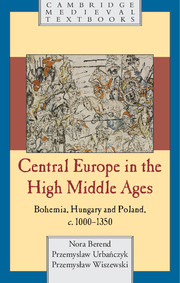Book contents
- Frontmatter
- Contents
- Note and acknowledgements
- Maps
- 1 Introduction: did Central Europe exist in the Middle Ages?
- 2 The history of the region and the question of origins
- 3 The formation of polities and Christianization
- 4 Political life and government, c. 1050–c. 1200
- 5 Society and the economy, eleventh–twelfth centuries
- 6 Ecclesiastical history, eleventh–thirteenth centuries
- 7 New developments of the thirteenth century
- Select bibliography
- Index
- References
7 - New developments of the thirteenth century
Published online by Cambridge University Press: 05 June 2014
- Frontmatter
- Contents
- Note and acknowledgements
- Maps
- 1 Introduction: did Central Europe exist in the Middle Ages?
- 2 The history of the region and the question of origins
- 3 The formation of polities and Christianization
- 4 Political life and government, c. 1050–c. 1200
- 5 Society and the economy, eleventh–twelfth centuries
- 6 Ecclesiastical history, eleventh–thirteenth centuries
- 7 New developments of the thirteenth century
- Select bibliography
- Index
- References
Summary
Radical transformations from the end of the twelfth century meant that, in many respects, there was discontinuity between the history of the eleventh and twelfth centuries on the one hand, and of that of the thirteenth on the other. The thirteenth century was a period of great tension between rulers and the nobility, of the devastating Mongol invasion and of innovations and new beginnings. In Hungary and Poland, the power of the nobility was on the rise, leading to political fragmentation, whereas, in contrast, in Bohemia the ruler acquired the royal title. The Mongols invaded all three countries and with the exception of Bohemia defeated the local rulers in battle. The extent of the devastation they caused in each country is open to debate. Social and economic changes included the more widespread use of writing in administration and legal cases; the development of towns and monetization; and an increase in the role of immigrants.
The growing number of settlers arriving from German-speaking lands – townsmen, peasants, knights – together with the increasing attractiveness of German courtly culture for elites triggered both co-operation and conflicts between locals and newcomers. Yet the new culture that emerged from the meeting of different traditions was much more important than conflicts. Benefits for rulers were especially significant. Chartered towns with fortifications and a new organizational form (communes), and their resulting standing as communities in relation to rulers, were the visible sign of change. Castellanization, the process of building castles as residences for knights, not just for royal administration, was another such sign. In the countryside, new spatial organization was introduced by western immigrants and widely adapted by local landowners in the second half of the thirteenth century. Social, legal and economic organization also affected the system of power. Instead of orally transmitted rights, written and commonly accepted laws and privileges became the norm.
- Type
- Chapter
- Information
- Central Europe in the High Middle AgesBohemia, Hungary and Poland, c.900–c.1300, pp. 408 - 491Publisher: Cambridge University PressPrint publication year: 2013

